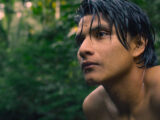
A rose is a rose is a rose. That may be true, and who am I to argue with Gertrude Stein? But a pear is not a pear is not a pear, as is quickly apparent in Rosie Stapel’s debut feature, Portrait of a Garden. There are many, many varieties of pear. They come in a wide variety of colors and shapes. They have both boring and funny names. They take a great deal of time to prune, especially if you have a lot of them. And boy, do gardeners Daan van der Have and Jan Freriks have a lot of them.
The subject of Stapel’s film is the oldest “kitchen garden” in the Netherlands, dating back to 1630. More than just an elaborate park, its many fruits and vegetables are harvested and sold. The 85-year-old Freriks is the master pruner, applying his immense knowledge of classical gardening to the extensive estate. His is a tradition that goes all the way back to the 17th and 18th centuries, codified by the gardeners of Versailles. His modern Dutch garden may not rival that of Louis XIV, but that hardly means the trees shouldn’t be forced to grow their branches in the right direction.
That’s not a joke, by the way. Freriks is an expert in the art of espalier, by which trees are grown in patterns against a wall. The results are mesmerizing, but they also take quite a while. In fact, much of the work in the garden is longterm. The current restoration project has already lasted 23 years, making up for a long period of neglect. But gardening on this scale is always a game of patience. The two men are remarkably stoic about this. When they acquire new cherry trees, they do not consider it a frustration that they will not bear fruit for six years. Rather, they see it as evidence of at least six more years of the garden’s life.
And while their garden is not at immediate risk, they do have things to worry about. Stapel doesn’t spend much time exploring the business side of things, but she does feature a number of broader conversations between Freriks and Van der Have about the state of agriculture. They bemoan the arrival of monoculture and the stranglehold large corporations have on the lives and livelihoods of small farmers. Freriks has seen The Netherlands change from a society of farmers into an industrial nation, where no one grows their own food. His is nearly a lost art, made obsolete by a world of mechanization and corporate greed.
But Stapel, presumably well aware of how many documentaries have already covered this precise point, does not dwell on the state of things outside the garden. Instead, she devotes her energy to capture its particular virtues. Portrait of a Garden plays like a rich photo album of fruits and vegetables, a bounty so diverse that it feels as if not a single plant appears more than once. The August harvest sequence is especially magnificent. Stapel rapidly cuts between boxes of fruit, rolling through the countless varieties of colorful pears with the energy of a stop-motion PES cartoon. It’s a showcase for her sense of color and design, strengths from her work as a painter and art director.
Yet not every sequence in Portrait of a Garden has a similarly bouncy mood. Nor does every shot of a vegetable beam with the classically-posed veneration of Jiro Dreams of Sushi. Stapel’s greatest accomplishment is in the dynamic structure of her film, which subtly responds to the change of the seasons. Her camera is often stationary in winter, frozen by the garden’s slumber. Her spring sequences make excellent use of aerial shots, flying across the garden to showcase the full breadth of the bloom. And the autumn, of course, is a time to showcase the extravagant colors of the season’s bounty. In a world dominated by industrial agriculture, as well as documentaries decrying that phenomenon, Portrait of a Garden is a relaxing and delightful interlude.
Portrait of a Garden opens on October 26th at Film Forum in New York City.




